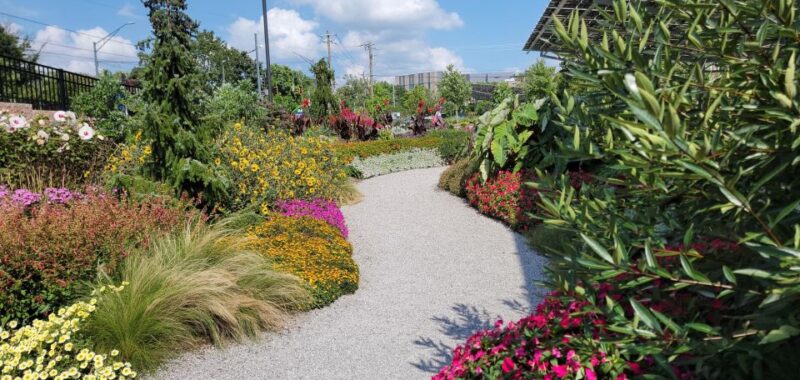Note: Information for this trials report was provided by Lynn Lorio, Annual Plant Trials Assistant/Horticulturist at the Cincinnati Zoo & Botanical Garden.
Climate in our area was variable throughout the summer. July was for the most part normal for temperatures and precipitation; however, August and September were very irregular. In August, the climate was very dry and hot, with high temperatures consistently above average (87.2°F) and 14 total days with temps above 90. At the end of the month, we experienced a seven consecutive day prolonged stretch of 90+ degrees, the longest streak since 2012. It was abnormally dry, with only 1 inch of rain in August (Cincinnati normally see’s 3+ inches of rain).
As of September, Hamilton County experienced a moderate drought with low precipitation most of the year (4 inches below average). The weather conditions during Aug and Sept especially affected our trials in terms of irrigation. Though our beds are on automatic irrigation, adjustments needed to be made to account for the hotter and drier weather. Hand watering all container trials was more frequent than usual to keep up with conditions.
In our trials, annual plants are received by various breeder and growing companies and are installed in May throughout our various garden beds in and around the Zoo, in addition to our offsite trial location at Rockdale Academy Learning Garden. Trial gardens are maintained by seasonal Zoo horticulture staff with the help of volunteers throughout the grow season. We try to perform maintenance and care similar to a home garden setting. Our plants are well labeled with trials uniquely conducted in a garden setting from July through September by our staff, volunteers, and the general public.
This year we trialed more than 850 varieties. Plants are rated on a scale from 1 to 5, where we observe plant vigor, health, ornamental value, urban sustainability, and value to wildlife. The overall purpose of our plant trials is to help the horticulture industry bring a better plant to our many visitors that can serve as a tool for plant selection in an urban garden setting.
We do not have a top-rated/best performing list yet, but keep an eye out for our 2024 Best Performing Annuals at https://cincinnatizoo.org/gardens/plants/.
Our annual plant trial program is unique in that we partner with plant breeders, wholesale growers, and brokers, to showcase annual plants throughout our Zoo gardens that appeal to landscapers, gardening centers, and gardening enthusiasts. This past August, in partnership with Eason Horticulture Resources, we hosted our second annual Breeders Showcase & Trials Program, where breeders, growers, industry horticulturists from public gardens, garden centers, nurseries, and landscaping companies were given an opportunity to tour our trial gardens.
Our trials more than doubled this year. In addition to annuals, we have also added many new and upcoming tropical grasses, Elephant Ears, Hibiscus, Dipladenia and Mandevilla.
We trial for wildlife and pollinator attraction, and we also strive to take notice and compare varieties that resist common cultural challenges, such as powdery mildew and soil fungi.
We inspire our 1.9 million visitors and our many volunteers to plant for urban wellness and encourage them to take part in our plant trials during our public and volunteer trial days. We also make note of reliability from veteran annual varieties over many years with a Hall of Fame logo that is printed on the label.
In terms of climate and weather, we have found this year to be particularly challenging because the sun is more intense. The temperatures are extremely high during the day and often to an extreme low in comparison to night (especially in spring). In early summer, there were periods of intense downpours followed by periods of no water. This made scheduling irrigation particularly challenging.
Here are a few plants that impressed me the most this year.
- Rudbeckia ‘Sunbeckia Graffiti’ (Flamingo Holland) – This series was one that was impressive. They have large flowers, including some that are double flowers, in unique colors with a long bloom time for several months. Favorite colors include Cherry, Scarlet, and Caramel, as well as ‘Sunbeckia Marilyn’.
- Ipomoea ‘Sweet Georgia Sweet Potato’ (Green Fuse Botanicals) – This series offers an entire line that displays excellent vigor as an impressive groundcover or a fountain over a wall. All the colors seem brighter and slightly different from many of the colors already out there.
- Petunias – The new mini petunias are very impressive. They are vigorous and floriferous. So far, most seem resistant to soil fungus. These include Petunia ‘Blanket Purple’ and Petunia ‘Blanket Silver Surprise’ (Green Fuse Botanicals), and Petunia ‘Itsy’ Pink or White (Syngenta Flowers). The entire Petunia Supertunia Mini Vista (Proven Winners) series did great, with Petunia ‘Supertunia Mini Vista Plum Veined’ as a new stand out.
- Celosias – Sakata has put out some impressive Celosias to their collection, especially ‘Flamma Rose’ and ‘Burning Embers’. Celosia ‘Dragon’s Breath’ is one of our Cincinnati Zoo Hall of Fame annuals and Children’s Choice Award winner, that consistently performs well year after ye
Throughout the trialing period, pollinator abundance was also evaluated by observing a 1.5-foot by 1.5-foot area for 10 seconds. The following plants displayed the highest count of 20 or more pollinators:
- Salvia ‘Salgoon Lake Como’ (HilverdaFlorist)
- Salvia ‘Salgoon Lake Onega’
- Euphorbia ‘Euphoric White’ (Syngenta Flowers)
- Scaevola ‘Whirlwind Pink’ (Proven Winners)
Find more 2024 field trials information here.
1
1
5
See What Stood Out at the Cincinnati Zoo and Botanical Garden 2024 Plant Trials



























